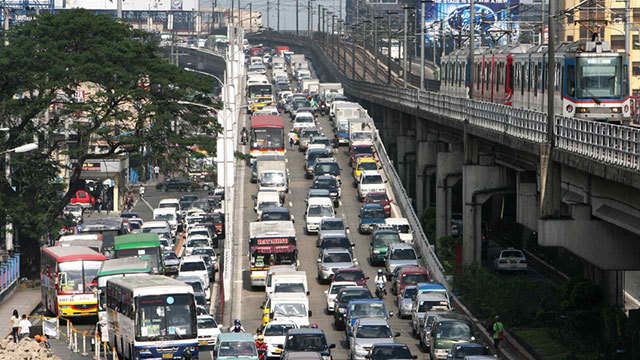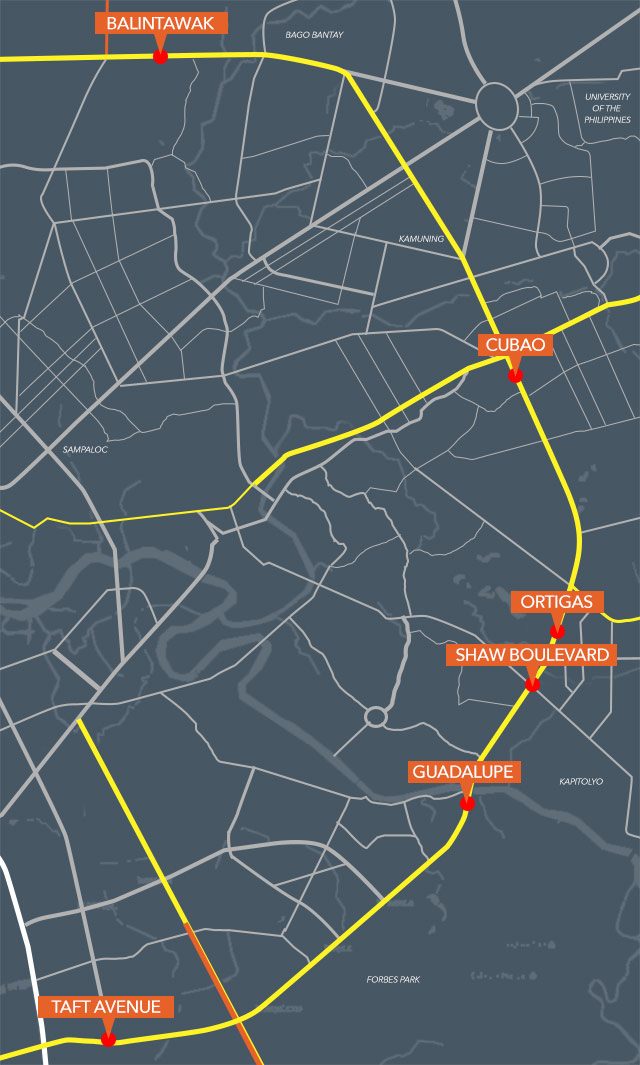SUMMARY
This is AI generated summarization, which may have errors. For context, always refer to the full article.

MANILA, Philippines – Authorities involved in Metro Manila traffic management have agreed to prioritize easing traffic in 6 major “choke points” along major thoroughfare EDSA, Malacañang announced on Tuesday, September 1.
Palace Communications Secretary Herminio Coloma Jr said in a news briefing that the agreement was reached in a meeting presided by President Benigno Aquino III, who ordered a review and fine-tuning of proposals to ease traffic in the metropolis.
“After a meeting presided over by the President, it was agreed that priority action will be taken to clear major intersections that are traffic congestion ‘choke points’ along EDSA,” Coloma said.
These are:
- Balintawak
- Cubao
- Ortigas
- Shaw Boulevard
- Guadalupe
- Taft Avenue
Coloma said the President also approved the deployment of the Philippine National Police Highway Patrol Group (HPG) “to serve as the lead traffic law enforcement agency on EDSA.”
The HPG will have “continuing support” from the Metropolitan Manila Development Authority (MMDA), Land Transportation Office (LTO), and the Land Transportation Franchising and Regulatory Board (LTFRB), he added.
‘Effective’ traffic law enforcement
Coloma also bared some of the “immediate action steps” agreed upon in the meeting, while the government finalizes its comprehensive traffic plan:
- Stricter enforcement of the bus lanes along EDSA
- Clearing of obstructions on EDSA and alternate routes
- Continuing consultations with bus and public utility operators, truckers and port users, and other stakeholders
During the meeting, Aquino ordered the submission of “detailed” implementation plans” of proposals to ease traffic congestion, Coloma said.

When asked, Coloma said there will be a stronger enforcement of traffic laws to speed up traffic flow, especially in the so-called “choke points.”
“Siyempre kinakailangan diyan ay matiyak na ‘yung mga traffic laws natin ay masusunod at walang nanghaharang, walang nagsu-swerving, walang naga-unload at loading sa hindi dapat. Kaya iyon ‘yung malinaw na direksyon – ‘yung effective traffic law enforcement,” he said.
(We have to ensure that traffic laws are followed – there would be no obstruction, no swerving, no loading and unloading in prohibited areas. That is the clear direction – effective traffic law enforcement.)
Asked about the lead role given to the HPG in EDSA traffic management, Coloma said that “even the MMDA recognized the need for a unified enforcement and effective presence” in this regard.
Coloma stressed that while the HPG will take the lead role, it will be supported by the MMDA, and LTO and LTFRB enforcers. He said the MMDA has around 500 enforcers, while the PNP can only deploy around 80 men per shift.
“There will still be a need for augmented traffic law enforcement,” he said.
Coloma also said that according to PNP chief Director General Ricardo Marquez, who attended the meeting, it will take the HGP a “few days” to be mobilized to EDSA.
The others at the meeting were Transportation Secretary Joseph Emilio Abaya, Public Works Secretary Rogelio Singson, Trade Secretary Gregory Domingo, Socioeconomic Planning Secretary Arsenio Balisacan, Labor Secretary Rosalinda Baldoz, and Cabinet Secretary Jose Rene Almendras.
They were joined by MMDA Chairman Francis Tolentino, Interior Undersecretary Austere Panadero, Presidential Management Staff chief Julia Abad, LTFRB Chairman Winston Ginez, LTO Assistant Secretary Alfonso Tan, Customs Commissioner Alberto Lina, and Philippine Ports Authority General Manager Juan Sta Ana.
Binay: Blame Aquino, not INC, for traffic
The Aquino administration has taken a beating from the public due to the worsening traffic in the capital region, aggravated by infrastructure projects.
Aquino had earlier proposed a weekly odd-even numbers coding scheme in Metro Manila, but predicted that it would be shot down by critics, particularly car owners.
The Japan International Cooperation Agency estimated that the Philippines stands to lose up to P6 billion a day by 2030 because of worsening traffic jams.
The Palace meeting comes a day after the Iglesia ni Cristo ended a days-long protest rally that paralyzed parts of the metropolis. This angered those who endured the hours-long traffic on the major road. (READ: INC protesters anger commuters, stranded motorists)
Vice President Jejomar Binay said on Tuesday that the INC should not be solely blamed for the traffic in EDSA, since traffic there had been “horrendous” even before the INC rally.
“Ang naging isyu sa INC rally ay ang traffic. Pero tandaan natin na bago pa mag-rally ang INC ay terible na ang traffic. Huwag nating kalimutan na ito ay dahil manhid at palpak ang administrasyon,” Binay said.
(The issue regarding the INC rally was traffic. But we have to remember that even before the INC staged its rally, the traffic was already terrible. Let’s not forget that this is because of this insensitive and incompetent administration.)
Binay, who served as chairman of the MMDA’s precursor, the Metro Manila Authority, said the government should strictly enforce traffic rules and run after colorum busses that contribute to the worsening traffic problem. – Rappler.com
Add a comment
How does this make you feel?
There are no comments yet. Add your comment to start the conversation.